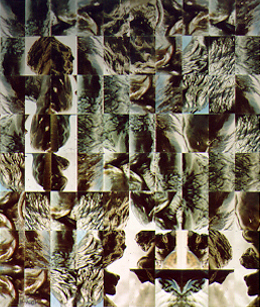
I discovered both myself and my art while making impromptu collages. Paper, x-acto and glue, books and magazines. Excellent images on paper more beautiful than newsprint. Later I moved on to photomosaics — images from my camera butted up in a tight grid. The grid form pushed me to create images which flowed across the grid lines and stole your attention from them. If you savored my image you could not focus on the grid, and vice versa.
I was playing with those two artforms far in the back of my mind when ‘click’ I saw the fundamental difference between them. Fundamental. Collage lets you paste a smaller image on a background image. If a tractor besmirches your glorious landscape, paste a swan on top of it.

Collage is a 3d artform. Yes its made from materials commonly thought of as 2d, but when one image can block another that is a 3d phenomenon. Its not available to you in a photomosaic which gives the artist nowhere to hide the nasty bits — the off-tune detail that will skew the meaning of your completed work, the deodorant ad, the moldy vegetable.
________________



Here’s a quick synopsis of my view of the Dimensions. Not a physicist’s understanding but an instructive play with semantics.
This sheet of business paper is the epitome of 2D, yes, width x length. But what if the paper’s for watercolorists? Then it has dimples, surface texture, a 3D aspect. I think of this 2d/3d region as bas-space, a continuum that begins with flat flat 2d. That surface develops 3d qualities with texture, or that favorite detective story clue, the impression emphatic writing makes on the sheet below. Shade over that with a pencil and you can read what the evildoer wrote. 3d emerging from 2d again. Or complicating it.
In reliefs 3d can build incrementally and logically outward from mere etching to low relief to high relief — and now imagine a kind of duct-tape-removal sound as it pops away from its substrate. Sculpture in the round.
Linguistically rich turf. We throw around the terms 2d and 3d as if we knew them, as if we knew the difference between cabbages and plums. But when you think about origami, a rolled newspaper, a once-folded sheet with a minor faint crease — it can be rewarding to ponder the nuances.
And here I stop, a step away from topology, from tesseracts, Klein bottles, Mobius strips. Because to think about these you must plant your feet on very different turf.
________________
All this ensues from my blogpost of February 4, Architectural Message of Chartres Cathedral. Architecture is usually spoken of as a 3D artform, rooms, domes, stairways. Volumes. But humans are necessarily smaller scale. In order to interact with architecture you must approach it, meander in it, tire of its lengthy halls. Thus the 4th dimension time becomes part of what an architect must design for. You don’t route traffic to the throne room through the scullery.
Likewise grand public architecture taxes the architect with producing the right silhouette. A fortress from a distance should look grim and intimidating, a palace must show luxe even far off on the horizon. Architects are employed to understand these messages and to deliver them.
Sculpture in the round also has this 4D aspect. If you see the Nike of Samothrace from the front you may guess the backside but you have to walk around it to be sure the sculptor hasn’t add a tail.
Also last week I also spoke of barn-raising in 1800s America, how it took a community to accomplish the feat. Then after the work came dancing and feasting, festivities where humans made merry together. And thus wove a deeper community.
Today as you drive across rural America many of these structures are slumped sideways, abandoned. Yet think of the planning and sweat that went into these massive buildings. Interesting that hardly any houses which would have gone with the barns are seen from the road. Houses are flimsier. They didn’t tap such a widespread community in order to rise. A community now morphed and unrecognizable.

